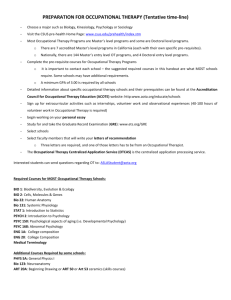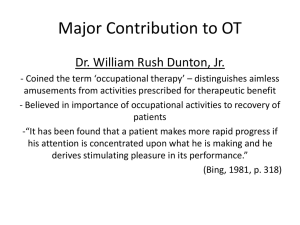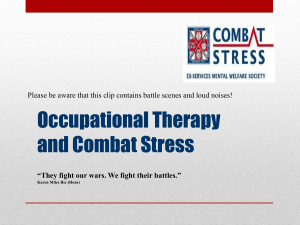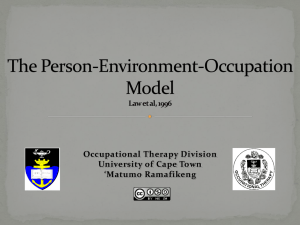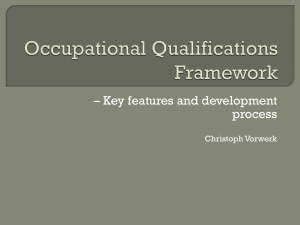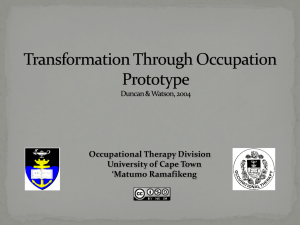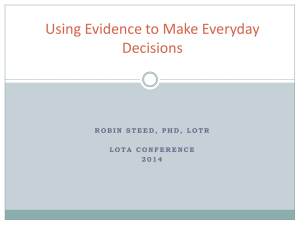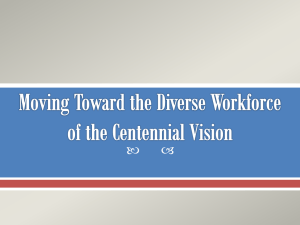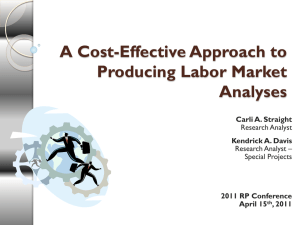Improving Function and Quality of Life Through Occupation: The
advertisement
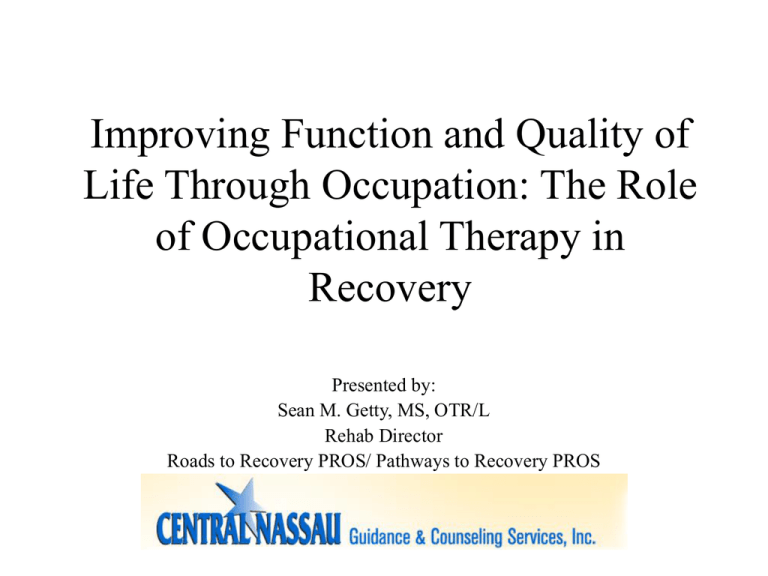
Improving Function and Quality of Life Through Occupation: The Role of Occupational Therapy in Recovery Presented by: Sean M. Getty, MS, OTR/L Rehab Director Roads to Recovery PROS/ Pathways to Recovery PROS Learning Objectives • • • • • Identify the role of the occupational therapist in facilitating recovery for people with mental illness Identify the fundamentals of occupational therapy and how these align with the core components of mental health recovery. Identify treatment approaches utilized by occupational therapists utilized at various stages of recovery. Identify some of the recovery-based, client-centered assessments utilized by occupational therapists to facilitate recovery. To understand the importance of meaningful occupation in the recovery process. What is Occupational Therapy? “The practice of occupational therapy means the therapeutic use of occupations, including everyday life activities with individuals, groups, populations, or organizations to support participation, performance, and function in roles and situations in home, school, workplace, community, and other settings.” (AOTA, 2004) “Occupational therapy services are provided for habilitation, rehabilitation, and the promotion of health and wellness to those who have or are at risk for developing an illness, injury, disease, disorder, condition, impairment, disability, activity limitation, or participation restriction.” (AOTA, 2004) “Occupational therapy addresses the physical, cognitive, psychosocial, sensory-perceptual, and other aspects of performance in a variety of contexts and environments to support engagement in occupations that affect physical and mental health, well-being, and quality of life.” (AOTA, 2004) Basic Tenets of OT • • • • • • • Occupation-Based Practice Empowerment Client-Centered Approach Holistic Approach Strengths-Based Context-Based Practice Cultural Diversity What is Recovery • 10 Fundamental Components of Recovery – – – – – – – – – – Self-Direction Individualized and Person-Centered Empowerment Holistic Non-Linear Strengths-Based Peer Support Respect Responsibility Hope - U.S. Department of Health and Human Services (2005) Areas of Assessment & Treatment • Areas of Occupation 1. 2. 3. 4. 5. 6. 7. 8. • Activities of Daily Living Instrumental Activities of Daily Living Rest and Sleep Education Work Play Leisure Social Participation Activity Demands • Client Factors1. Values, Beliefs, & Spirituality 2. Body Functions 3. Body Structures • Performance Skills 1. 2. 3. 4. 5. Motor & Praxis Skills Sensory-Perceptual Skills Emotional Regulation Skills Cognitive Skills Communication & Social Skills • Performance Patterns 1. 2. 3. 4. • Habits Roles Rituals Routines Context and Environment 1. 2. 3. 4. 5. 6. Cultural Personal Temporal Virtual Physical Social Intervention Approaches 1. Create or Promote – Creating intervention strategies without assuming that a disability is present or that any factors would interfere with performance – Resembles health promotion model 2. Establish or Restore – Leads to re-establishment of a lost skill or ability – Examples: money management, parenting, leisure skills 3. Maintain – Preservation of performance 4. Modify – Revise the current context or task demands to support performance in the natural setting – Examples: social networks can be changed; temporal modifications like duration or sequence of a task can be changed; backward chaining – Match a context or task to the person’s abilities – Nothing is changed about the person 5. Prevent Assessments • • • • • • Activities of Daily Living Behavioral Assessments Cognitive Behavioral Assessments Evaluations of Social Interactions Vocational Assessments Sensory Processing Assessments Treatment Settings • • • • • • • Acute & Long Term Care Facilities Residential and Day Programs Skilled Nursing Facilities Community-Based Mental Health Centers Schools Military Installations Employment Practice OT in an Acute Facility • Evaluation • Managing Symptoms through Occupation • Alternatives to Restraints OT in Community Settings • Evaluation – Identifying the underlying skills impeding goal acquisition • Improve Function – Carrying out a plan to improve function and achieve the individual’s goals • Wellness • • • • Social Environmental Physical Emotional • • • • Spiritual Occupational Intellectual Financial (Swarbrick, 2006) • • • • • • American Occupational Therapy Association (2004) Definition of occupational therapy practice for the AOTA Model Practice Area. Bethesda, MD: Author. (Available from the State Affairs Group, 4720 Montgomery Lane, PO Box 31220, Bethesda, MD 20824-1220) Dornan, D.H., Felton, C., Carpinello, S. (November 14, 2000) Mental Health Recovery from the Perspectives of Consumer/Survivors. Presentation at the American Public Health Association Annual Meeting, Boston, MA. New York State Office of Mental Health (2010). Part 512 PROS Regulations. Retrieved from http://www.omh.state.ny.us/omhweb/pros Substance Abuse and Mental Health Services Administration. (2010). Mental Health, United States, 2008. HHS Publication No. (SMA) 10-4590, Rockville MD: Center for Mental Health Services, Substance Abuse and Mental Health Services Administration Swarbrick, M. (2006) A Wellness Approach. Psychiatric Rehabilitation Journal, 29(4) 311-314 U.S. Department of Health and Human Services (2005) National Consensus Statement on Mental Health Recovery. Retrieved from http://store.samhsa.gov/shin/content//SMA05-4129/SMA05-4129.pdf
